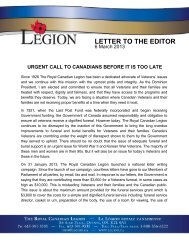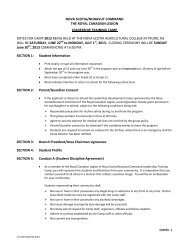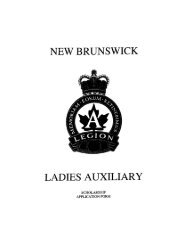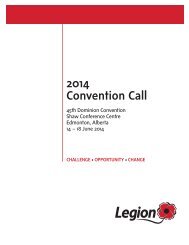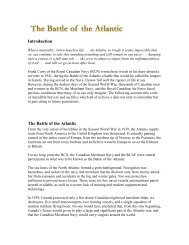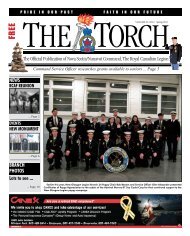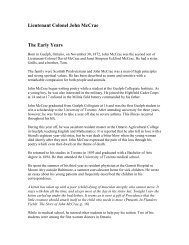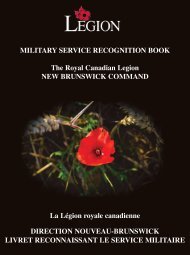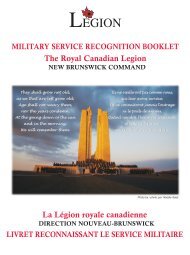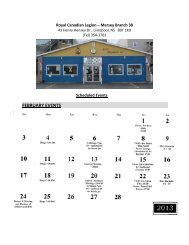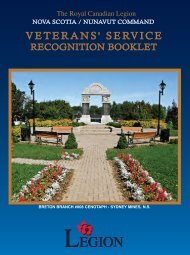You also want an ePaper? Increase the reach of your titles
YUMPU automatically turns print PDFs into web optimized ePapers that Google loves.
<strong>Fall</strong> <strong>2009</strong>T H E O F F I C I A L P U B L I C A T I O N O FN O V A S C O T I A / N U N A V U T C O M M A N D13David Andrews<strong>2009</strong> PilgrimageRepresentativeStewiacke, Branch 70How do I begin?I suppose I could startback in the fall of 2008when I decided to applyfor this pilgrimage.It did not take muchto convince me that thiscould be the opportunityof a lifetime, so I acquiredthe proper forms andquickly filled them outand sent them to Command.After a fair period ofwaiting for the decisionfrom the Committee, IEuropean pilgrimage was the “highlight of my life”was truly excited when theword came that I wouldbe going on the pilgrimageas Nova Scotia/Nunavut Command’s representative.The thoughtsof what was ahead for mehad my head spinning attimes. To be able to visitthe battlefields, memorialsand cemeteries throughoutFrance, Belgium andHolland would be a dreamcome true.Once I received thematerial on the trip,including the schedule ofeverywhere we would bestopping, it became abundantlyclear that thereSouth Shore legionnaires honour the Devil’s BrigadeDan HennesseyPR ChairmanBranch 24 BridgewaterEven the impending threat of Hurricane Bill loomingoff the coast could not keep a group of <strong>Legion</strong>nairesfrom the South Shore travelling to Halifax totake part in the wreath laying ceremony to honour theworld famous 1st Special Service Force (better knownas the Devils Brigade) who were in Halifax to hold their63rd Annual Reunion.The 1st Special Service Force was activated on July20, 1942 as a joint <strong>Canadian</strong>-U.S. force of three smallregiments and a service battalion. Fort William HenryHarrison in Helena, Montana was chosen as the primarytraining location, due to its flat terrain for airbornetraining and its close proximity to mountains for skiand winter training Following its initial training periodin Montana, the 1st SSF relocated to Camp Bradford,Vermont, on April 15, 1943, and to Fort Ethan Allen,Vermont, on May 23, 1943. On July 4, 1943, it arrivedat the San Francisco Port of Embarkation.It was at Anzio that the Germans dubbed the 1stSpecial Service Force the “Black Devils.” The diaryof a dead German soldier contained a passage thatsaid, “The black devils (Die schwarzen Teufel) are allaround us every time we come into the line. The soldierwas referring to them as “black” because the brigade’smembers smeared their faces with black boot polish fortheir covert operations in the dark of the night. DuringAnzio, the 1st SSF fought for 99 days without relief.It was also at Anzio that the 1st SSF used their trademarkstickers; during night patrols soldiers would carrystickers depicting the unit patch and a slogan writtenwould more to this than Ihad imagined. There werealso more forms to fillout for Dominion Commandand our tour leader.Among them was one forspecial requests. I filledthis one out requestingto be the wreath layer atBeny-Sur-Mer Cemeteryduring our service there.My Great Uncle Kennethand three other men frommy community are buriedthere.In less than a week Ihad received an e-mailfrom Dominion Commandwith pictures ofUncle Ken attached. Thesecond e-mail was fromour tour leader, JohnGoheen, informing methat he had done someresearch on my uncleand believed that he hadfound the area that he hadbeen killed in. He alsoinformed me that this sitewas on our schedule ofstops.So imagine how I wasfeeling when I realizedthat not only would I beat he landing site of theNorth Nova Scotia Highlanders,but I would befollowing his trail inlandto where he eventuallydied at Hell’s Corner. TheThe diary of a dead German soldiercontained a passage that said, “Theblack devils (Die schwarzen Teufel) areall around us every time we come intothe line.in German: “Das dicke Ende kommt noch,” said totranslate to “The Worst is yet to Come”, placing thesestickers on German corpses and fortifications.To look into the eyes of these men today , one canonly imagine how the memories of those days stilllinger in the recess of their minds. While many ofthe folks there to watch the event mingled , an air ofexcitement could be felt as the bus carrying the survivingmembers pulled to the curb at Grand Paradein Halifax. While they were exiting the bus the firstnoticeable thing was their uniforms , as each man hadtheir medals, ribbons and insignias proudly displayedand of course the famous symbol that would representthe unit, the Red Spearhead shoulder patch, which borethe words USA and Canada. Just to be in their presencewas an honour and even in their mid 80s and 90s, youcould still see signs of that unit’s cohesiveness by theribbing that was taking place between the membersThere were representatives from both the US and<strong>Canadian</strong> military in attendance and when someonefrom the crowd would come up and ask what it wasfor and heard the name the Devil’s Brigade, whetherit was from their history books or the Hollywoodfollowing day I would belaying the wreath at theBeny-Sur-Mer Cenotaphand visiting his grave.I was sure that after thefirst two days, of followingUncle Ken’s part ofthe war, that the rest ofthe trip would be a loteasier for me. I was sowrong.As the tour continuedfrom one site to another,I found myself wonderingif anyone couldcome here and not feelthe emotions that I wasfeeling. At one battlefieldafter another John gaveus the picture of whathad happened there. Thisincluded maps and somephotographs of thesesites. To actually be standingwhere so many gavetheir all for us becamequite emotional on a dailybasis.As I sit here typing thisup, I realize that each ofthe thirty-two people onthe tour had a connectionother than being <strong>Legion</strong>Members. At almost everystop there was someoneamong our group thathad a personal connectionwith the battle or cemetery.Tears were aContinued on Page 14movie , many stayed to pay their respects The actualwreath laying ceremony was a solemn occasion withmany dignitaries placing wreaths to honour the group, but the first wreath placed was designed with flowersand was the insignia of the Devils Brigade which wasboth delicate in design but powerful in its image. Theceremony was capped off with a low level fly over bya <strong>Canadian</strong> CF18 Hornet which was amazing , but themaster of ceremonies District E Commander RCL,Roger Purnell, did mention that the Hornet would becoming back over the crowd and the suggestion wasmade to turn down your hearing aids for the second flyover , which was an incredible display of flying. Oncethe event ended most of the participants dropped bythe Vimy Branch of the <strong>Royal</strong> <strong>Canadian</strong> <strong>Legion</strong> whowas hosting a reception. The tables were filled withwarriors of yesterday and today and was an impressivedisplay of comradeship. The reception was topped offwhen one of the tables of the Devils Brigade began tosing “Its A Long Way to Tipperary” and many of thetables joined in which took even us youngsters back tothe early days of World War ll.The 1st Special Service Force Association holds theirreunion each year , but as the years go by , reality willmean that one day this group will only live in the hearts,minds and memories of those left behind to ensurethat their legacy lives on forever. This was a time in ourhistory that we needed a special force to stand in theway of tyranny and these men took that challenge andby doing so have placed themselves forever in the historybooks and will always have the gratitude of bothnations which they represented. We will never forgettheir sacrifices.



